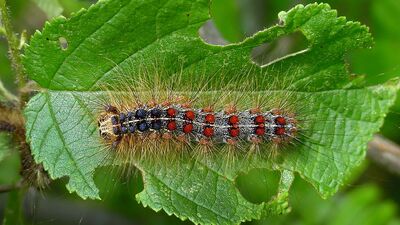Wisconsin Could See Another Bad Spongy Moth Outbreak
Thursday, May 2nd, 2024 -- 9:01 AM

(Danielle Kaeding, Wisconsin Public Radio) Wisconsin saw its worst spongy moth outbreak in more than a decade in 2023.
According to Danielle Kaeding with Wisconsin Public Radio, the state could see a repeat this year, unless spring rains help decrease their population. Spongy moths, renamed in 2022, are invasive insects native to Europe, Asia and North Africa.
They were first introduced in the late 1800s, and outbreaks occur every five to 10 years. Spongy moths are destructive during the caterpillar stage when the voracious eaters can completely strip leaves from entire forests.
Bill McNee is the state Department of Natural Resources’ forest health specialist for southeastern Wisconsin. He said Wisconsin saw record defoliation across 373,000 acres last year compared to the previous record of 347,000 acres set back in 2010.
This year, spongy moths could be just as bad, he said, since caterpillar survival was higher than normal with the warm winter in addition to last year’s dry spring and summer. “The outbreak in parts of Wisconsin is expected to continue similar to 2023,” McNee said.
“We’re also getting a number of reports and seeing egg masses out in the forest, indicating that the defoliation and abundant caterpillars are likely to spread into new parts of the state.”
McNee said the insects’ spread is most likely to occur in northern Wisconsin, as well as some parts of southern counties. While some areas could see another bad summer, he said others may see an end to the outbreak.
Wetter than normal weather this spring could also support the growth of a fungal disease that affects the caterpillars, causing their population to decline or collapse. The caterpillars feed on up to 300 species of trees and shrubs during spring and early summer.
They prefer trees that are common in mixed hardwood forests, including oak and aspen. A single spongy moth egg mass can contain up to 1,000 eggs. Patrick Engelken, an entomologist with the U.S. Forest Service, said he’s expecting a larger spongy moth outbreak early this spring.
He said that’s likely to affect most forested areas in northern Wisconsin where trees lost their leaves last year, including the Chequamegon-Nicolet National Forest. The outbreak was most problematic in the Bayfield peninsula with defoliation observed on about 145,000 acres in Bayfield County.
Feel free to contact us with questions and/or comments.




